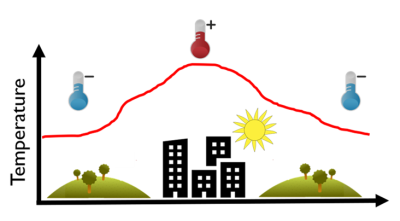蚂蚁:指示全球变化影响的哨兵

气候变化和城市化是影响物种分布的重要因素,对物种的生存带来了极大的威胁。生物入侵会改变物种间的相互作用,因此是生物多样性保护需要关注的重要问题。在这个不断变化的世界里,蚂蚁的命运将会如何?蚂蚁是许多生态系统的优势物种,几乎出现在所有的陆地生境中。因其体型小且有筑巢习性,很容易随着人类活动被带到世界各地,其中就包括了最具侵略性的种类。蚂蚁无法进行内源性生理产热,体温随外界环境温度而变化(属于外温动物),所以很容易受到气候变化的影响。在过去,对蚂蚁的研究解答了关于生态和进化的许多问题。现在,我们该如何通过蚂蚁更好地理解各种全球变化及其相互作用呢?
1. 全球变化:对生物多样性有何影响?

droughts 干旱
extreme events 极端气候事件
Land use changes 土地用途改变
Agricultural activities 农业活动
deforestation 砍伐森林
urbanization 城市化
anthropogenic changes 人为变化
pollutions 各类污染
biological invasion 生物入侵
Threat for biodiversity 威胁生态多样性
人类活动给生物多样性造成了越来越大的压力,包括栖息地的转化和碎裂化、自然资源的过度开发、污染和气候变化。现在,这些环境变化在全球范围内清晰可见,因此被称为“全球变化”(图1)。在全球变化中,最为大众所熟知的或许是气候变化和城市化。气候变化影响气候变量(温度、降水等)的趋势和气候事件(洪水、干旱)的频率。例如,21世纪的全球变暖,其规模堪比过去6500万年中最剧烈的全球变化。对未来气候的预测显示,全球变暖将进一步加剧,海平面将上升,极端气候事件的频率和强度也会增加。
这些变化已经并继续将对生物多样性产生巨大的影响,波及个体、种群、物种乃至生态系统。例如,温度的变化可以影响生物的生存、繁殖和地理分布,甚至改变其物候,比如导致蝴蝶过早羽化、候鸟提前回迁或植物提早开花(见 气候变化和全球化,昆虫入侵的驱动力;鸟类如何适应气候变化? )
城市化也是一种速度快、规模大的全球变化,对生物多样性产生了巨大的影响。当前,全球超过50%的人口、欧洲大约80%的人口生活在城市里面[1]。近年来,在大多数欧洲国家,城市化呈爆炸性发展趋势,首先对大城市产生影响,之后逐渐影响到规模较小的城镇,甚至偏远的乡村[2]。因此,城市扩张是土地转变为城市景观的一个重要原因,且城市景观受到人类的显著改变。城市地区的特点包括高密度的建成区、高蓄热不透水地表、庞大的交通基础设施网络及其周边高度密集的农业活动。就生物多样性而言,城市生境是由人工地表、工业污染、人为干扰以及能量循环和物质循环等共同构成的、被彻底改造过的生境。因此,城市化对所有的环境要素都会产生影响,包括土壤、水文、植被以及小气候[3]。例如,城市通常比附近的农村更温暖(城市热岛效应[4],图2),夜间温度更高,或者白天的最高温度更高。

因此,从生态学的角度来看,城市化往往对生物多样性有负面影响。城市一般位于自然物种丰富的地区,在保护物种多样性上面临着更严峻的挑战[5]。除了上述影响外,城市化还可能给栖息地质量带来一系列次生影响,包括可用栖息地减少、剩余栖息地高度碎裂化,以及栖息地受到边缘效应影响增加[6]。研究显示,许多类群(脊椎动物、昆虫、植物、真菌和微生物)的多样性已经因污染、物质循环中断或景观破碎化而受到负面影响(见 地衣与环境质量)。
在过去的二十年里,生物入侵[7]也受到了科学界的大量关注。虽然从严格意义上讲,生物入侵既不是新现象,也不完全由人类引发,但是随着交通和贸易的迅速发展,生物入侵发生的地理范围、复发率和相关物种数量都在急剧增加(见 ;为什么虎蚊有如此强的入侵性?)。因此,作为外来物种的“传播者”,人类的作用可能已经超过了自然传播的作用,使得外来物种能够克服本可以排斥甚至消灭入侵繁殖体的自然随机力和生物抗性(与本地物种的竞争)[8]。因此,在全球化时代,生态系统和人类社会已经因为入侵物种的扩散发生了彻底的改变。目前这种前所未有的大规模生物入侵已被学界认定为全球变化的一种独特形式[8]。
所以,生物入侵是目前生物多样性保护的重要议题之一。外来物种通过大量互动对本地物种产生负面影响,包括竞争、捕食、杂交、摄食植物、寄生等直接相互作用,以及疾病或干扰模式的变化等间接作用。外来入侵物种改变了生态系统的功能,对其他种群造成负面影响,甚至导致一些物种局部灭绝[9]。例如,在英国,外来灰松鼠(Sciurus carolinensis)和本地红松鼠(Sciurus vulgaris)之间的竞争导致了红松鼠[10]的分布范围大幅缩小。
2. 关注全球变化,为什么要研究蚂蚁?

社会性昆虫的特点是具有高度的社会性,称为真社会性[11],即世代重叠、合作育幼和繁殖分工(种群中区分参与繁殖与不参与繁殖的阶级[12])。其中,蚂蚁被认为是研究生态和进化[13]的理想生物模型。目前在各个大陆上已经发现了至少15,000种蚂蚁及其亚种,而且还可能有许多种群仍未被发现。蚂蚁出现在几乎所有的陆地生境中,包括热带森林、沙漠、草原、城市和农田[12]。在一些生态系统中,蚂蚁的生物量占陆地总生物量的15%。
由于蚂蚁数量丰富、种类多样,使其成为了生物监测的理想模型:它们通常是“关键种”,对种子传播、土壤化学等许多生态系统功能有重大影响,主要是因为蚂蚁极其突出的生活方式多样性。例如,有游牧型蚂蚁,有在树木、土壤或植被碎屑中筑巢的蚂蚁,有掠食性蚂蚁,食谷性蚂蚁,还有会种植蘑菇的蚂蚁物种甚至会种植蘑菇[13]。由于蚂蚁体型小且有筑巢习性,很容易被人类携带到世界各地,例如盆栽植物贸易、土地挖掘或木材采运等。事实上,超过200种蚂蚁已经在原栖息地以外建立了种群[13],至少600种蚂蚁已经迁移出了原来的分布区[14]。其中一些已经显示出入侵性,也就是说,它们已经大量繁殖,而且其扩张对当地的生物多样性和人类健康产生了负面影响。
蚂蚁是外温昆虫,体温取决于所在生活环境的温度。因此,幼虫的发育和成虫的活动直接受制于气候条件,这就使得蚂蚁的分布受到气候的强烈影响(见图3中火蚁的例子)[15]。因此,蚂蚁提供了良好的模型来研究生物体对温度变化以及气候变化的一般反应。。
3. 城市中的蚂蚁

Resistance to extreme temperatures and droughts 抵御极端温度和干旱
activity preserved under artificial light 人工光线下进行活动
Nuptial flight adapted to anthropogenic constraints 突破人为环境限制的“婚飞”
在高度城市化环境中生存的动物里,蚂蚁是衡量城市化环境影响的良好指标[16]。对于不同的蚂蚁来说,城市化影响的大小和方向不仅取决于物种特征及其对干扰的敏感性,而且还取决于物种间的相互作用及其扩散能力(图4)。
许多种蚂蚁极少出现在城市地区,但有几种蚂蚁在人类最密集的栖息地中十分常见(例如法国的黑蚁(Lasius niger),图5)。由于城市中的蚂蚁群落和附近农村地区的蚂蚁群落之间存在重大差别,城市生态学中经常会对蚂蚁群落进行分析[17]。
4. 入侵性蚂蚁

蚂蚁是社会性昆虫,因而拥有许多有利于生物入侵的特点。在入侵地,群居的生活方式不仅提高了对资源的利用能力和与当地物种的竞争能力,而且还增强防御捕食者的能力。负责繁殖的个体长出翅膀(“飞蚁”)提高了传播能力。在繁殖模式上的灵活性也是一项优势。例如,酒瓶酸臭蚁属于酸臭蚁(Tapinoma nigerrimum)的酒瓶酸臭蚁(Tapinoma magnum),是欧洲地区的一种新的入侵物种,它们采用一雄多雌制[12](图6),因而能够更为迅速地扩散,加快了新种群的扩张。一雄多雌制还能迫使一些雄性个体离开种群,进入新栖息地并吸引繁殖期雌性到来,从而建立新的种群。
有一些群居昆虫物种是研究的关注焦点,例如臭名昭著的墨胸胡蜂(Vespa velutina)对蜜蜂的影响是近年来很多研究的主题[18]。然而,蚂蚁无疑是破坏性最大、分布最广的群居昆虫。入侵物种研究组(Invasive Species Research Group)[19]表明,在世界上危害最大的100个入侵物种中,有5种是蚂蚁:阿根廷蚁(Linepithema humile)、红火蚁(Solenopsis invicta)、大头蚁(Pheidole megacephala)、小火蚁(Wasmannia auropunctata)和细足捷蚁(Anoplolepis gracilipes)。

高度入侵性的蚂蚁通常呈单群落状,比如阿根廷蚁,它们形成了超大型蚁群,工蚁和蚁后共居,在相互独立的巢穴间来回活动。这有两个优势:与彼此孤立且可能相互攻击的蚁群不同,超大型蚁群领地成本更低(攻击较少),这种模式使工蚁能很快达到很高的密度。例如红火蚁至少九次从美国入侵台湾、澳大利亚等地[20],它们可以实行高度的一雄多雌制,在一个群落中蚁后可达200个。基于同样的特性,细足捷蚁(“黄疯蚁”)入侵印度洋中部的圣诞岛,其密度达到每公顷7000万只。在15年的时间里,大约有1500万只地蟹被蚂蚁喷射的甲酸杀死,导致该物种衰落。
蚂蚁入侵会带来高昂的经济损失,也给环境带来巨大变化,还会对当地的生物多样性产生强烈的影响。而且,本地蚁种可能会受到极大的负面影响,因为入侵蚁种具有更大的竞争优势,甚至会捕食和袭击本地蚁种的巢穴。蚂蚁入侵还会对生态系统功能、生态系统服务[21]以及人类社会的许多构成要素产生影响,如改变食物网动态、改变物质循环、减少授粉[12]。
5. 全球变化的相互作用

Chnages in climatic suitability 气候适宜度变化
Linepithema humile 阿根廷蚁
Lasius neglectus 毛山蚁
对于大多数物种来说,城市化通常意味着栖息地退化且不利于生存,因为许多本地物种对人类干扰十分敏感。对这些物种来说,城市化意味着良好栖息地的破坏和碎裂化。然而,城市生态系统也为某些物种提供了机遇。许多研究高度关注由人类引入城市生态系统的众多物种[16]。城市的建设和扩张加速了本地物种的消失以及非本地物种取代本地物种[5]。最近的一些科学研究指出,在城市化程度更高的栖息地,外来物种的数量和多样性较高,无脊椎动物尤为明显[22](见:为什么虎蚊有如此强的入侵性?)。外来物种丰富度[5]增加可能有三个原因:
- 由于人口持续流动,外来物种在有意或无意间被带入到城市〔例如日本果蝇(Drosophila suzukii)通过食品供应链入境〕;进口外来宠物也会导致生物入侵(比如佛罗里达龟或长尾鹦鹉);
- 城市中存在有利于外来物种生存的生境,如资源和环境条件的良好组合、天敌(捕食者或竞争者)很少等,显著提高了宜居性;
- 进入城市的外来物种中,有一些可以耐受人类栖息地的独特环境条件(例如来自于热带的物种可以耐受更高温度),还有一些甚至可以利用城市环境提供的条件,比如虎蚊。(见 为什么虎蚊有如此强的入侵性?)
气候变化也可能加剧生物入侵。许多入侵物种现今的分布受到温度限制,气候变化可能使其入侵高纬度地区。极端天气事件,如强烈的热浪、飓风、洪水和干旱,可以增加外来物种的移动,同时削弱本地种群对生物入侵的抵抗力,从而推动了生物入侵(见 气候变化和全球化:昆虫入侵的驱动力)。例如,在法国,大多数入侵蚁种可能会随着气候变化而扩大分布范围(图7)[23]。
6. 铺道蚁案例

铺道蚁(Tetramorium immigrans)(图8) 是北美地区的入侵物种,在18或19世纪进入当地城市,是近年来被广泛研究的城市地区蚁种。
在法国,铺道蚁在不同空间尺度上的空间分布取决于气候和城市环境[24]。铺道蚁喜欢温暖和相对潮湿的环境,在人工微生境有大量分布(尤其以混凝土为特征的微生境)。如经常在混凝土中生活。在其分布区的北部,铺到蚁通常只分布于城市化程度最高的生境。在其参考分布区往北的方向,即气候对其不利的地区,铺到蚁只出现在巴黎或布拉格等大城市。图9显示了该物种在城市化栖息地[25]中利用人类资源的能力。因此,在法国北部的很多大城市中,尽管气候条件不适宜,但城市热岛效应使铺道蚁得以生存。

Traffic islands 交通岛
pavement 人行道
铺道蚁分布地区最北部的种群可能在近期才建立,受益于19和20世纪的城市化进程以及贸易、旅行和货运的繁荣发展。由于铺道蚁仅在城市地区生存,最可能导致该物种入侵的假设仍然是人类活动[26]。在其向北迁移的过程中会与当地种群发生接触,并与之发生基因交流[27]。该物种完美地展示了城市化和气候变化的相互作用以及对生物入侵的影响和促进作用(图10)。
7. 物种分布与多尺度相互作用

Introduction in southermost part of France 进入法国当地最南部
Moving toward the North in urban areas 向法国北部城市地区迁移
Negative interactions with other species 与其他物种产生负面互动
了解全球变化对物种分布的影响仍然是当今科学界面临的一个巨大的挑战。例如,气候变化和城市化共同改变了物种的分布,与这些全球变化相关联的各种因素在不同尺度上发挥作用,并且相互影响,因此,解析此类因素对生物多样性的影响变得更加复杂。物种分布格局是复杂的多尺度相互作用的结果。在科学研究中,这种相互作用没有得到充分的考虑。
然而,气候变化、土地利用方式变化和外来物种入侵极有可能同时发生,因此,可以预期它们对生物多样性的影响会存在协同效应。例如,城市通常比邻近的农村温度更高,在局地尺度上,城市化对当地气候的影响与正在发生的全球变暖相当,表明城市化可以极大地加剧当地的气候变化。即使只考虑两种全球变化(如这里讨论的气候变化和城市化),由于尺度效应和交互作用,也会导致极大的复杂性。同时,污染、农业或采伐森林等其他主要的人为变化也可能加剧全球变化的影响。
显然,单一的局部全球变化对某物种分布的因果研究无法有力诠释该物种分布发生的进程。因此,必须采用更全面的方法,将多个尺度上的多种变化综合考虑,对全球变化的影响进行深入研究。在这方面,蚂蚁无疑会是一个研究模型,无疑要选择蚂蚁作为模型,它们已经证明了自己的能力。过去,针对蚂蚁的研究诠释了各个的全球变化的作用;毫无疑问,未来也可以通过蚂蚁研究不同全球变化的相互作用,更准确地量化其对生物多样性同时产生的影响……
8. 重要信息
- 气候变化和城市化相互作用,改变了物种的分布。
- 蚂蚁数量和种类繁多,在大部分陆地生境中定居,影响着许多生态系统功能。
- 蚂蚁体型小,在土壤或植物中筑巢,很容易随人类活动而迁移。因此,很多蚂蚁成为了入侵物种。
- 蚂蚁是外温昆虫,对温度变化很敏感。因此,它们的分布范围受气候条件制约。
- 蚂蚁是研究城市化如何影响环境的良好指标,因而也是城市生态学中常见的研究对象。
- 蚂蚁是研究不同全球变化复杂相互作用的理想模型——对铺道蚁(Tetramorium immigrans)的研究就是一个很好的例子。
参考资料及说明
封面照片:城市化环境中的铺道蚁(Tetramorium immigrans)[来源:本杰明·格凡德(Benjamin Gerfand)]
[1] https://www.un.org/en/events/citiesday/assets/pdf/the_worlds_cities_in_2018_data_booklet.pdf
[2] Antrop, M. (2004). Landscape change and the urbanization process in Europe. Landscape and urban planning, 67(1-4), 9-26.
[3] Seress, G., et al. 2014. Quantifying the urban gradient: a practical method for broad measurements. Landscape and Urban Planning, 131, 42-50.
[4] https://www.notre-planete.info/terre/climatologie_meteo/ilot-chaleur-urbain.php
[5] McKinney, M. L. (2006). Urbanization as a major cause of biotic homogenization. Biological conservation, 127(3), 247-260.
[6] In ecology, edge effects reflect changes in the structure of species populations and communities that occur when two very different habitats exist side by side in an ecosystem. This terminology is often used to refer to the boundaries between natural and artificial habitats.
在生态学中,边缘效应反映了在生态系统中两种截然不同的生境的交界处,物种种群和群落结构的变化。这个术语通常用来描述自然和人工栖息地之间的界限。
[7] Invasions of non-native species introduced voluntarily or involuntarily outside their original range and capable of persisting and proliferating in newly colonized ecosystems
生物入侵指的是非本地物种有意或无意地被引入到其原有的范围之外,并在新的生态系统中建立种群,持续生存和增殖。
[8] Ricciardi, A. (2007). Are modern biological invasions an unprecedented form of global change? Conservation Biology, 21(2), 329-336.
[9] Pyšek, P., et al (2017). Displacement and local extinction of native and endemic species. In Impact of biological invasions on ecosystem services (pp. 157-175). Springer, Cham.
[10] Gurnell, J., et al. 2004. Alien species and interspecific competition: effects of introduced eastern grey squirrels on red squirrel population dynamics. Journal of Animal Ecology, 73(1), 26-35.
[11] https://www.nature.com/scitable/knowledge/library/an-introduction-to-eusociality-15788128/
[12] Hölldobler, B., & Wilson, E. O. (1990). The ants. Harvard University Press.
[13] Lach, L., Parr, C., & Abbott, K. (Eds.). (2010). Ant ecology. Oxford University Press.
[14] Miravete, V., et al (2014). How many and which ant species are being accidentally moved around the world? Biology letters, 10(8), 20140518.
[15] Sung, S., et al (2018). Predicting the potential distribution of an invasive species, Solenopsis invicta Buren (Hymenoptera: Formicidae), under climate change using species distribution models. Entomological Research, 48(6), 505-513.
[16] Heterick, B. E., et al. (2013). Urbanisation factors impacting on ant (Hymenoptera: Formicidae) biodiversity in the Perth metropolitan area, Western Australia: Two case studies. Urban Ecosystems, 16(2), 145-173.
[17] Philpott, S. M., et al. 2010. Ant diversity and function in disturbed and changing habitats. Ant Ecology. Oxford University Press, New York, 137-157.
[18] http://frelonasiatique.mnhn.fr/la-museliere/
[20] Ascunce, M. S., et al. 2011. Global invasion history of the fire ant Solenopsis invicta. Science, 331(6020), 1066-1068.
[21] 指为了确保人类的福祉,可以直接或间接从生态系统获得的商品和服务(千年生态系统评估,2005)
[22] Cadotte, M. W., et al (2017). Are urban systems beneficial, detrimental, or indifferent for biological invasion? Biological invasions, 19(12), 3489-3503.
[23] Bertelsmeier, C., & Courchamp, F. (2014). Future ant invasions in France. Environmental conservation, 41(2), 217-228.
[24] Cordonnier, M., et al (2019). Multi-scale impacts of urbanization on species distribution within the genus Tetramorium. Landscape Ecology, 34(8): 1937-1948.
[25] Penick, C. A., et al. 2015. Stable isotopes reveal links between human food inputs and urban ant diets. Proc. R. Soc. B, 282(1806), 20142608.
[26] Cordonnier, M., et al (2020). Effect of the urbanization-climate interaction on the expansion of the pavement ant in South-eastern France. Basic and Applied Ecology, 44, 46-54.
[27] Cordonnier, M., et al (2019). From hybridization to introgression between two closely related sympatric ant species. J Zool Syst Evol Res, 57(4): 778-788.
环境百科全书由环境和能源百科全书协会出版 (www.a3e.fr),该协会与格勒诺布尔阿尔卑斯大学和格勒诺布尔INP有合同关系,并由法国科学院赞助。
引用这篇文章: CORDONNIER Marion (2024年3月11日), 蚂蚁:指示全球变化影响的哨兵, 环境百科全书,咨询于 2024年7月3日 [在线ISSN 2555-0950]网址: https://www.encyclopedie-environnement.org/zh/vivant-zh/ants-sentinels-impact-global-change/.
环境百科全书中的文章是根据知识共享BY-NC-SA许可条款提供的,该许可授权复制的条件是:引用来源,不作商业使用,共享相同的初始条件,并且在每次重复使用或分发时复制知识共享BY-NC-SA许可声明。






